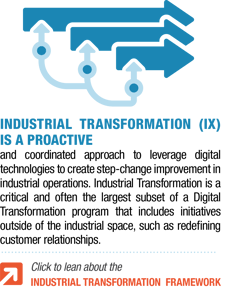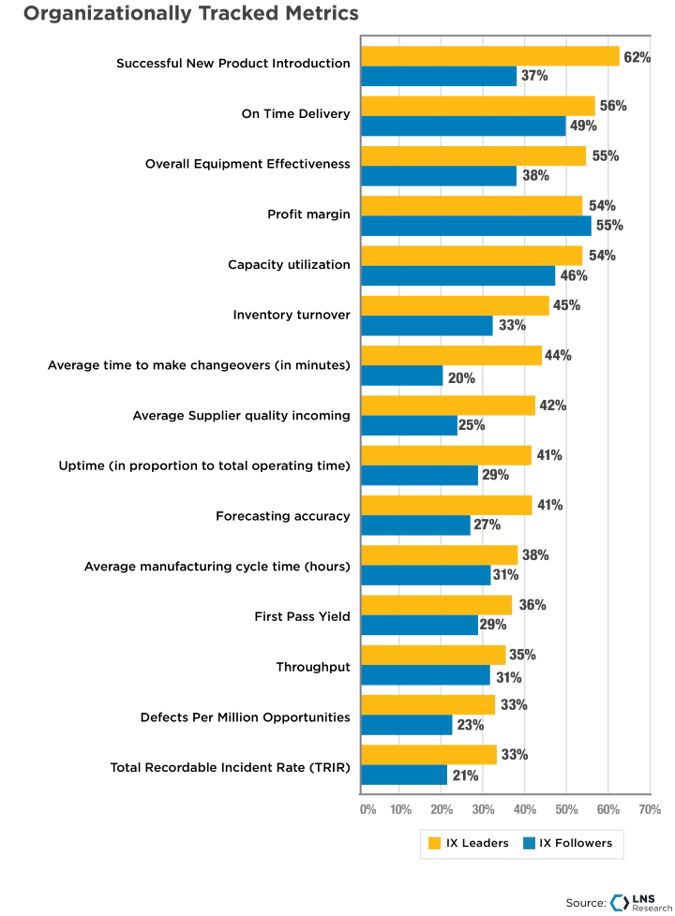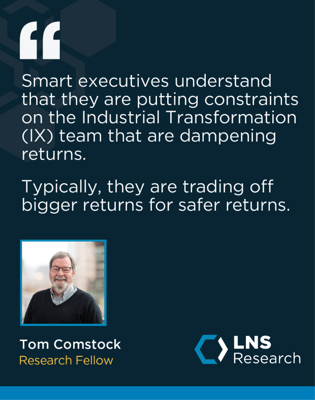Let’s look at the data and why.
First a quick reminder: Jim Collins and Jerry Porras first coined the term BHAG (Big Hairy Audacious Goal, pronounced BEE-hag) in their 1994 book and it has inspired thousands of companies since then. Like John F. Kennedy saying that the US wanted to be on the moon by the end of the decade – without any kind of plan to know it was possible – BHAGs are giant goals that are deliberately visionary and equally overwhelming. BHAGs are not just stretch goals, they are transformative. So, it would seem they are right for IX...but the facts do not line up.
Big But Achievable Goals™ (BBAG) and Going Wide are the Keys to IX
There is a fine art to setting goals around an IX Program. IX Leaders are setting significant goals, and hitting them, but those goals are one-half as ambitious as the BHAG goals being set by Followers. Across a series of 15 Value Chain metrics, LNS Research has found that IX Leaders are setting Big but Achievable Goals (BBAG)™.
%20Improvement%20Goals%2c%201200x418.png?width=675&height=235&name=Average%20Industrial%20Transformation%20(IX)%20Improvement%20Goals%2c%201200x418.png)
However, saying they are setting lower goals only captures one dimension of the difference. They are setting smaller goals across a much wider scope of the program. LNS Research asks about scope in several different ways. When we asked about functions (Quality, manufacturing, etc.) within the scope of the program, we found that IX Leaders are more likely to include 18 of 19 functional areas targeted in their program and often by a significant margin. The average IX Leader includes six functions compared to three by Followers. The data was equally true when we asked about the “initiatives” within the scope of the program. Leaders were more likely to have included nine out of nine initiatives we queried. The average IX Leader includes four initiatives on average compared to two by Followers. IX Leaders are reaching widely across the company for potential financial impact.
%20Program%20Initiatives%2c%20720x708.png?width=675&height=664&name=Industrial%20Transformation%20(IX)%20Program%20Initiatives%2c%20720x708.png)
To net it out, IX Leaders are setting a normalized goal of one-half the improvement across TWICE the program scope! While not mathematically accurate, it is probably fair to conclude that the reason IX Leaders are significantly more likely to be achieving their goals is that they are setting them at something like ONE-QUARTER of the goals being set by Followers. Big, But Achievable.
BBAG is not “Sand Bagging”
There is a reason we used the phrase “Big” in our label. BBAGs are not easy to achieve nor are IX Leaders letting their teams roam free.
Executives at leading IX organizations are still pushing aggressively on their IX teams. This can be seen in the operating metrics that are being measured. IX Leaders are more likely to be tracking 16 of 18 manufacturing metrics, often quite more likely. Additionally, when we look at improvement goals associated with transformation, we see that IX Leaders are setting marginally higher objectives than Followers. Again, IX Leaders are hitting their targets.

Why are BHAGs Not Working?
So, if BHAGs are transformative, why don’t they work in Industrial Transformation? Four reasons seem to apply:
-
-
-
"Built to Last" was about corporate strategy. Responsibility for execution was dispersed across the company so the “overwhelming” nature of the goal was also dispersed. IX in its initial stages is typically highly centralized into the hands of a small program team. Further, our research indicates that budgets for IX are quite small relatively and focused primarily on pilots and proofs-of-concept. It is easy to understand that a monumental goal is simply demotivating in the early stages of transformation. IX Program teams in Follower organizations are challenged by goals that appear unachievable with the resources allocated.
-
The rollout funding model across the manufacturing network ensures that the IX program team knows they do not have control. Plants are required to fund the rollout of solutions in over 60% of cases. Massive goals and little or no control are not a recipe for success.
-
In those early stages of transformation “momentum,” and therefore quick wins, define the program. It is imperative to demonstrate to the company that digital technologies and new methodologies really can have an impact on the organization. Organizations typically reach out to the best plants in the network (the “lighthouse plants”) to demonstrate these new technologies. These plants are, by definition, atypical, and so solutions developed for these best plants cannot easily be rolled out to the rest of the manufacturing network. In other words, the implementation plans being imposed on IX teams deliberately mute returns.
-
IX is particularly challenging as solutions must be deployed across a manufacturing network that varies by manufacturing model, culture, Operational Technology (OT) deployed, and digital maturity. Benefits realization is delayed until the solution can be rolled out across the whole manufacturing network.
-
Manufacturers are particularly challenged if they have long lifecycle assets (steel factories for example) where a corporation is very likely to have a wide range of assets performing the same task. It may be possible to get a monumental improvement online but not be able to replicate it across older assets.
All in all, smart executives understand that they are putting constraints on the IX team that are dampening returns. Typically, they are trading off bigger returns for safer returns.
What works
Clearly setting Big But Achievable Goals is a best practice associated with transformation. Teams are stretched and motivated. The goals are aligned with the company’s stage of transformation maturity.
LNS Research also advocates the use of “Vision Stories.” Dr. Howard Gardner of Harvard has said: “Stories constitute the single most powerful weapon in a Leader’s arsenal.” IX Leaders consistently articulate a “vision story” of what digital operations will eventually look like. Core to the vision is aspirational concepts. IX Leaders are typically building their Vision Story around one or more of the following concepts:
-
-
-
Getting closer to the customer
-
Building more agile operations (particularly given the demand swings and supply chain disruptions associated with COVID)
-
Becoming a data-driven organization
-
Accelerating innovation
-
Increasing collaboration internally and with suppliers and customers
Additionally, they are integrating and aligning their Vision Story with the overall corporate strategy. Vision stories paint the big picture associated with BHAGs without the demotivating measurements.
Final Thoughts for CEOs
Setting goals is never easy. It is particularly hard in the early stages of Industrial Transformation where experimentation and pilots are the charters. Be sure to align the scale of the goals to the level of risk you are willing to take. Big goals with small commitments are a recipe for stagnation and failure.

All entries in this Industrial Transformation blog represent the opinions of the authors based on their industry experience and their view of the information collected using the methods described in our Research Integrity. All product and company names are trademarks™ or registered® trademarks of their respective holders. Use of them does not imply any affiliation with or endorsement by them.